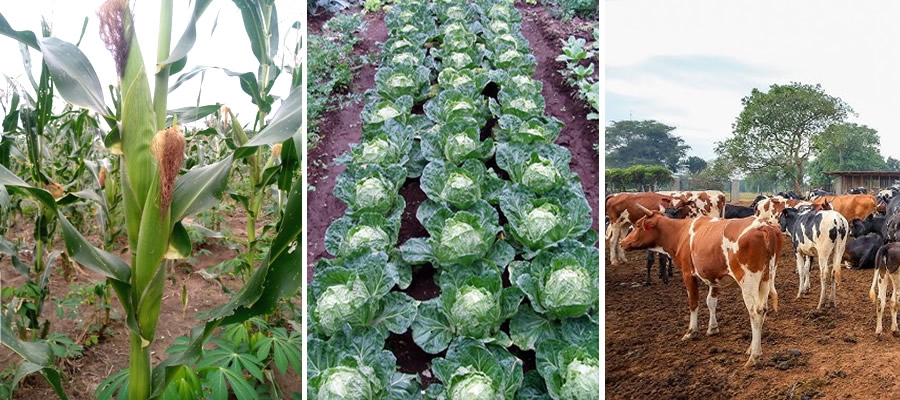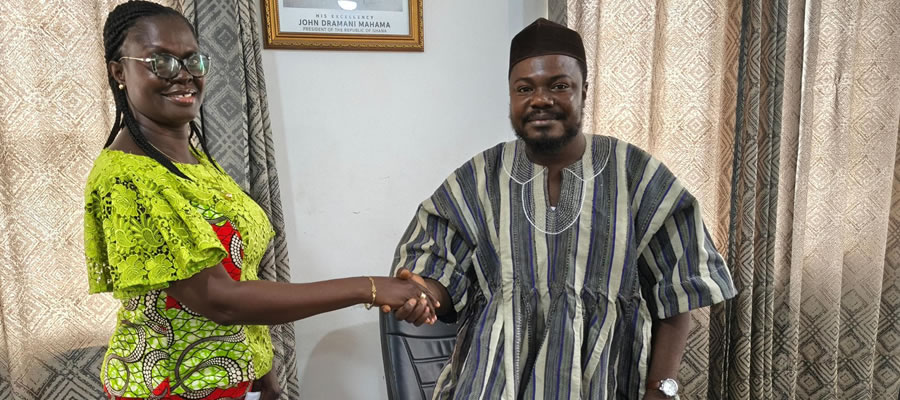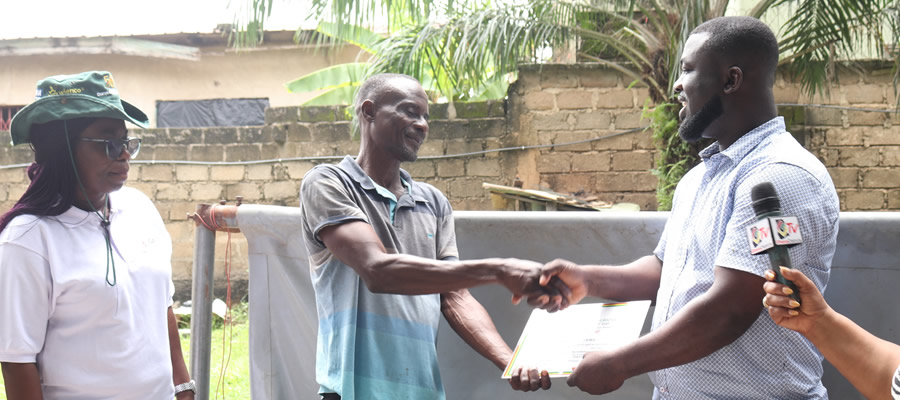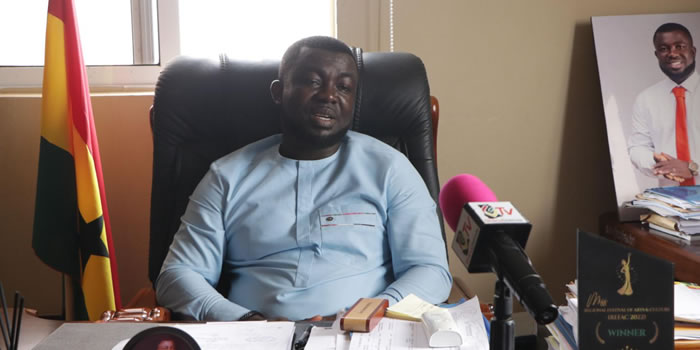

DEMOGRAPHIC CHARACTERISTICS
Demographic Characteristics
Population Size and Distribution Data from the 2021 Population and Housing Census (PHC) indicates that the Assembly has a population of 235,292 out of which 116,481 (49.51%) are males and 118,811 (50.49%) are females. With a population growth rate of 2.9%, the current population is estimated at 235,292 (2021) and is expected to reach 264,232 by the end of the planning period (2025). The average household size is estimated as 3.1 which implies that there are currently 75,901 households in the Municipality
The Census Report (2021) also indicates that 66.5% of the population falls within the economically active age group (15-64), with 30% and 3.5% falling within the 0-14 and 65+ respectively. This scenario indicates that, the municipality has adequate capacity in the supply of labor force for the production of economic goods and services.
The 2021 Population and Housing Census also estimates that 79% (185,881) of the population are in the Urban Areas with 21% (49,411.32) in the Rural Areas.
The census data further shows a Population Density of 368.06 per square kilometer which compares favorably with the Greater Accra Density figure of 1,681 per square kilometers.
Gender Equality
According to the 2021 population census, the population of the municipality is estimated to be 235,292 out of which 116,481(49.51%) are males and 118,811(50.49%) are females. This indicates that there are more female than males.
Gender has become one of the most pressing issues in the municipality due to gender disparities. These disparities are usually shape by cultural stereotypes. In view of this, the municipality has integrated gender issues into the entire spectrum of its programmes and activities in order to foster good gender relations for mutual respect between the genders and eliminate gender disparity. This is to ensure that women will especially have access to services and information and exercise their responsibility and to address socio-cultural practices and underlining discrimination based on sex.
In spite of efforts to foster equality and eliminate gender disparity, there still exist bottlenecks that hinder the growth and development of women. Table 1.3 provides information on the reported cases of abuse against women as recorded by the Social Welfare and Community Development Department of the Assembly. These include the following:
• Physical and Emotional Abuses: This refers to the use of violence and verbal attacks to suppress the rights of women which usually deprive them of their dignity. According to the Social Welfare and Community Development Department (SWCD) of the Assembly this normally occurs between women and their partners (husband/boyfriend). The department explains that there have been cases where abuse have led to hospitalization and need for professional psychological care. Reports indicates that the situation is especially predominant among couples with the woman is economically dependent on the man. Another worrying trend from such cases is the unwillingness to press charges by victims of such abuse for fear of losing financial support from the men who perpetuates such behavior.
• Neglect and Non-maintenance: this refer to the situation where men leave the burden of providing for the daily needs of children they fathered to only the women. The SWCD reports that this situation is growing at an alarming rate and is very common among migrants’ women who tend to depend on men for their source of livelihood and ends up being taken advantage of.
• Women unemployment: this is considered as the root cause of the above-mentioned issues. The problem is especially dire among women who have migrated to the Municipality in search of non-existing jobs. The SWCD Department have over the years initiated various programmes to help address this situation. Prominent among them have been the following:
o Training of Women in Income Generating Activities such as on Antiseptic and Detergent Making
o Support to Women Groups on Entrepreneurship and Marketing of Product for Effective Business Growth (Also Introduce Groups to Markets)
o Mentoring of Girl Child from in selected JHS Institution
o And the construction of Market Infrastructure to support trading among women

Plate:1 Training of Women Groups in Income Generating Activities and Entrepreneurship
Migration (Immigration & Emigration) The Ghana Statistical Service define migration as the permanent change of residence or the movement of people in space often involving a change in the usual place of residence (2010 Population & Housing Census Report, 2014). The Report further explains that migration can indirectly affect the productive capacity through its selective effect on age and sex composition and can have significant demographic, social and economic impact on both source and destination.

Figure 4, provide an overview of the In-migration situation in the various regions of the country with that of the Greater Accra region of particular interest to authorities of the Municipality. This is because though there are no specific data on migration for the Ga North Municipality, it can anecdotally be said that the regional situation mirrors that of the Municipality. Rural-Urban type of internal migration where young men and women continue to migrate from rural area to the Municipality in search of non-existent white-collar jobs can be commonly observed.
There is also evidence of International Migration in the Municipality. This has been especially observed particularly from those from the West African sub-region who easily merge with the nationals and join the internal mobility of laborers.
The consequences/problems with migration that have been observed in the Municipality have included among others the following:
• Streetism: this can be observed in areas like Pokuase and Ofankor where most young migrants have been observe roaming the streets in the day time and trying to engage in some petty trading activities to service motorist who are usually stuck in traffic. Some who do not have any proper place of abode have been seen sleeping under highways and bridges at night. Those who are fortunate enough have been seen sleeping in makeshift structures mounted under High Tension Poles/Lines, Lorry Stations and Markets.
• Sexual/Physical Abuse: this phenomenon has been especially observed among independent child migrants many of whom are girls and lack the basic economic power to help them settle. They are thereby taken advantage off and in some cases become pregnant leaving them with additional mouths to feed. Some have ended up engaging in prostitution to survive. In May, 2021 the Assembly was moved to demolish structures at Pokuase being used by prostitutes and hide-outs for criminals. Most of the prostitutes were said to be migrants from Nigeria.
Within the next planning period (2022-2025) it is expected that programmes will be formulated to help address the blight of migrants with respect to areas mentioned above.
Religious Composition There is religious heterogeneity in the municipality. People are allowed to practice their faith without any hindrance. Consultation from Christian council and Muslim communities indicated that the Municipality is dominated by 81% Christians, 9% of the population belong to the Islamic religion, 8% are without any form of religion, Traditionalist (1%) whiles 1% are also with religious groups not specified as shown in the figure 4:
Figure 4: Religious Composition

Population Size and Distribution Data from the 2021 Population and Housing Census (PHC) indicates that the Assembly has a population of 235,292 out of which 116,481 (49.51%) are males and 118,811 (50.49%) are females. With a population growth rate of 2.9%, the current population is estimated at 235,292 (2021) and is expected to reach 264,232 by the end of the planning period (2025). The average household size is estimated as 3.1 which implies that there are currently 75,901 households in the Municipality
The Census Report (2021) also indicates that 66.5% of the population falls within the economically active age group (15-64), with 30% and 3.5% falling within the 0-14 and 65+ respectively. This scenario indicates that, the municipality has adequate capacity in the supply of labor force for the production of economic goods and services.
The 2021 Population and Housing Census also estimates that 79% (185,881) of the population are in the Urban Areas with 21% (49,411.32) in the Rural Areas.
The census data further shows a Population Density of 368.06 per square kilometer which compares favorably with the Greater Accra Density figure of 1,681 per square kilometers.
Gender Equality
According to the 2021 population census, the population of the municipality is estimated to be 235,292 out of which 116,481(49.51%) are males and 118,811(50.49%) are females. This indicates that there are more female than males.
Gender has become one of the most pressing issues in the municipality due to gender disparities. These disparities are usually shape by cultural stereotypes. In view of this, the municipality has integrated gender issues into the entire spectrum of its programmes and activities in order to foster good gender relations for mutual respect between the genders and eliminate gender disparity. This is to ensure that women will especially have access to services and information and exercise their responsibility and to address socio-cultural practices and underlining discrimination based on sex.
In spite of efforts to foster equality and eliminate gender disparity, there still exist bottlenecks that hinder the growth and development of women. Table 1.3 provides information on the reported cases of abuse against women as recorded by the Social Welfare and Community Development Department of the Assembly. These include the following:
• Physical and Emotional Abuses: This refers to the use of violence and verbal attacks to suppress the rights of women which usually deprive them of their dignity. According to the Social Welfare and Community Development Department (SWCD) of the Assembly this normally occurs between women and their partners (husband/boyfriend). The department explains that there have been cases where abuse have led to hospitalization and need for professional psychological care. Reports indicates that the situation is especially predominant among couples with the woman is economically dependent on the man. Another worrying trend from such cases is the unwillingness to press charges by victims of such abuse for fear of losing financial support from the men who perpetuates such behavior.
• Neglect and Non-maintenance: this refer to the situation where men leave the burden of providing for the daily needs of children they fathered to only the women. The SWCD reports that this situation is growing at an alarming rate and is very common among migrants’ women who tend to depend on men for their source of livelihood and ends up being taken advantage of.
• Women unemployment: this is considered as the root cause of the above-mentioned issues. The problem is especially dire among women who have migrated to the Municipality in search of non-existing jobs. The SWCD Department have over the years initiated various programmes to help address this situation. Prominent among them have been the following:
o Training of Women in Income Generating Activities such as on Antiseptic and Detergent Making
o Support to Women Groups on Entrepreneurship and Marketing of Product for Effective Business Growth (Also Introduce Groups to Markets)
o Mentoring of Girl Child from in selected JHS Institution
o And the construction of Market Infrastructure to support trading among women
Plate:1 Training of Women Groups in Income Generating Activities and Entrepreneurship
Migration (Immigration & Emigration) The Ghana Statistical Service define migration as the permanent change of residence or the movement of people in space often involving a change in the usual place of residence (2010 Population & Housing Census Report, 2014). The Report further explains that migration can indirectly affect the productive capacity through its selective effect on age and sex composition and can have significant demographic, social and economic impact on both source and destination.
Figure 4, provide an overview of the In-migration situation in the various regions of the country with that of the Greater Accra region of particular interest to authorities of the Municipality. This is because though there are no specific data on migration for the Ga North Municipality, it can anecdotally be said that the regional situation mirrors that of the Municipality. Rural-Urban type of internal migration where young men and women continue to migrate from rural area to the Municipality in search of non-existent white-collar jobs can be commonly observed.
There is also evidence of International Migration in the Municipality. This has been especially observed particularly from those from the West African sub-region who easily merge with the nationals and join the internal mobility of laborers.
The consequences/problems with migration that have been observed in the Municipality have included among others the following:
• Streetism: this can be observed in areas like Pokuase and Ofankor where most young migrants have been observe roaming the streets in the day time and trying to engage in some petty trading activities to service motorist who are usually stuck in traffic. Some who do not have any proper place of abode have been seen sleeping under highways and bridges at night. Those who are fortunate enough have been seen sleeping in makeshift structures mounted under High Tension Poles/Lines, Lorry Stations and Markets.
• Sexual/Physical Abuse: this phenomenon has been especially observed among independent child migrants many of whom are girls and lack the basic economic power to help them settle. They are thereby taken advantage off and in some cases become pregnant leaving them with additional mouths to feed. Some have ended up engaging in prostitution to survive. In May, 2021 the Assembly was moved to demolish structures at Pokuase being used by prostitutes and hide-outs for criminals. Most of the prostitutes were said to be migrants from Nigeria.
Within the next planning period (2022-2025) it is expected that programmes will be formulated to help address the blight of migrants with respect to areas mentioned above.
Religious Composition There is religious heterogeneity in the municipality. People are allowed to practice their faith without any hindrance. Consultation from Christian council and Muslim communities indicated that the Municipality is dominated by 81% Christians, 9% of the population belong to the Islamic religion, 8% are without any form of religion, Traditionalist (1%) whiles 1% are also with religious groups not specified as shown in the figure 4:
Figure 4: Religious Composition
Date Created : 2/13/2025 12:00:00 AM











 facebook
facebook
 twitter
twitter
 Youtube
Youtube
 +233 593 831 280
+233 593 831 280 0800 430 430
0800 430 430 GPS: GE-231-4383
GPS: GE-231-4383 info@ghanadistricts.com
info@ghanadistricts.com Box GP1044, Accra, Ghana
Box GP1044, Accra, Ghana